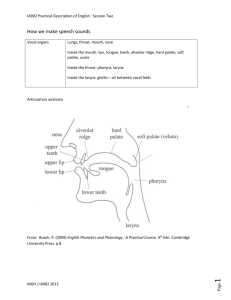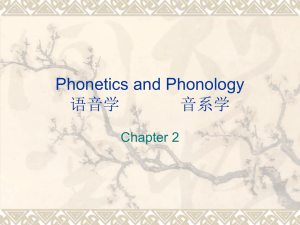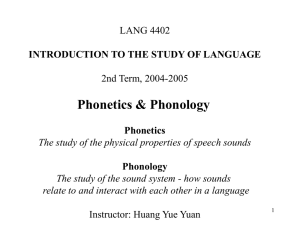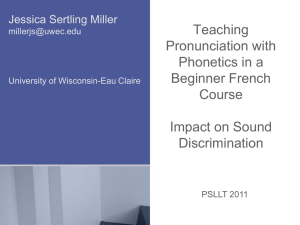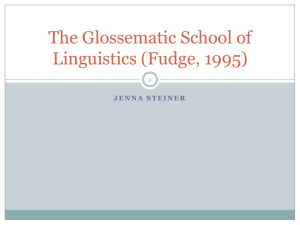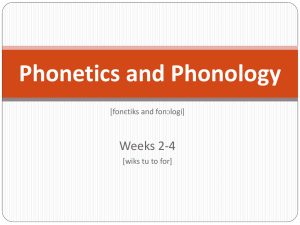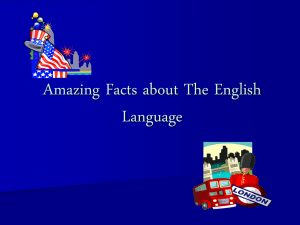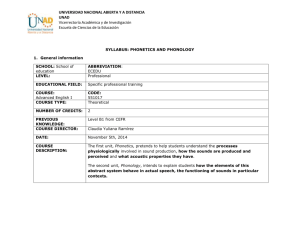English Phonetics and Phonology : A Practical Course.
advertisement
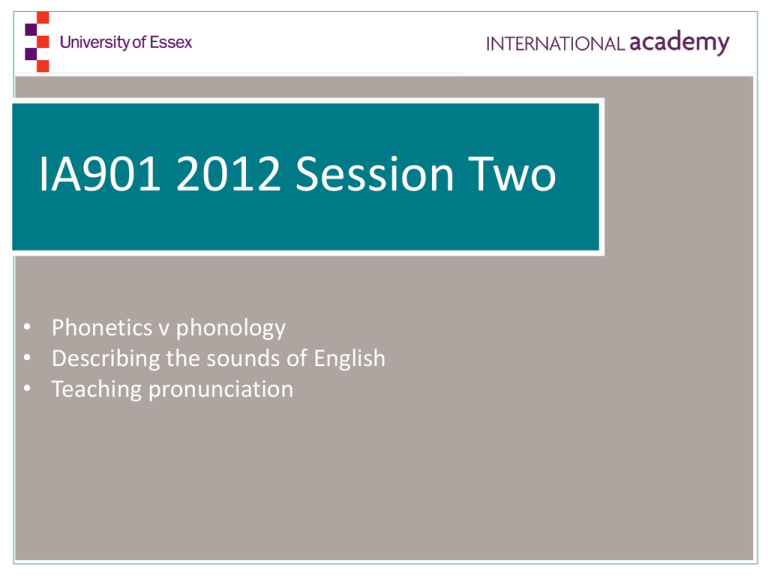
IA901 2012 Session Two • Phonetics v phonology • Describing the sounds of English • Teaching pronunciation Adrian Underhill’s Phonemic Chart 1. How useful do you think this chart is for describing the sounds of spoken English? 2. Have you used this chart in a classroom? 3. Should knowledge of this chart be a prerequisite for English language teachers? 4. Do you have any sympathy for this point of view? Underhill, A. 2005 Sound Foundations : Learning and Teaching Pronunciation. 2nd Edn. Macmillan Phonetics & Phonology Phonetics & Phonology Phonetics is concerned with the way we make, transmit, and receive speech sounds. There are three main branches of phonetics: articulatory, acoustic, and auditory. Phonology relates to the sound systems of languages and concerns itself with the way sounds relate to meaning in a given language. Phonetics v Phonology Phonetics: “the study of the production of speech sounds by speakers, their perception by hearers and their acoustic properties” Phonology: “the branch of linguistics which investigates the ways in which speech sounds are used systematically to form words and utterances” Katamba, F. (1989) An Introduction to Phonology Longman. p.60 Phonetics & Phonology 1. What’s the difference between a VOWEL and a CONSONANT? 2. How many VOWELS are there in English? 3. How many CONSONANTS? vowels consonants continuants / sonorants Underhill, A. 2005 Sound Foundations : Learning and Teaching Pronunciation. 2nd Edn. Macmillan Underhill, A. 2005 Sound Foundations : Learning and Teaching Pronunciation. 2nd Edn. Macmillan An experiment… Four Vowels When the following vowels are produced, what happens to the position of the lips, jaw, and tongue? 1 2 3 4 i: u: æ ɑ: Four Vowels i: u: æ ɑ: i: u: æ ɑ: Another experiment… Cardinal vowels Roach, P. 2009 English Phonetics and Phonology : A Practical Course. 4th Edn. Cambridge University Press. p.12 Do speakers of British English produce cardinal vowels? Roach, P. 2009 English Phonetics and Phonology : A Practical Course. 4th Edn. Cambridge University Press. p.12 Vowels in British English Roach, P. (2009) English Phonetics and Phonology : A Practical Course. 4th Edn. Cambridge University Press Vowels in British English Yet another experiment - on a blank piece of paper, can you draw a human mouth in 10 seconds? - now – in the same amount of time – can you draw the inside of a human mouth? In how much detail could you label these two diagrams? uvula houses the glottis The consonants Let’s see if anyone’s still awake! Look at these words for 10 seconds: uvular labiodental dental alveolar / post-alveolar bilabial velar palatal glottal Terms used to describe place of articulation: 1. both lips bilabial 2. lips and teeth labiodental 3. teeth dental 4. alveolar ridge alveolar / post-alveolar 5. hard palate palatal 6. soft palate (velum) velar 7. glottis glottal 8. uvula uvular Are any of these terms useful for your students? uvula Underhill, A. 2005 Sound Foundations : Learning and Teaching Pronunciation. 2nd Edn. Macmillan My attempts at visual representations in the classroom uvula uvula uvula uvula uvula uvula uvula Tactile experiences? uvula Manner of articulation Place and manner of articulation : an experiment How would you describe the difference between the way it feels to produce each of the following pairs of phonemes? 1. 2. 3. 4. 5. 6. /m/ and /n/ /p/ and /m/ /v/ and /ð/ /t/ and /s/ /l/ and /n/ /ʃ/ and /tʃ/ 7. /ŋ/ and /n/ 8. /ŋ/ and /g/ 9. /w/ and /m/ 10. /h/ and /s/ 11. /j/ and /w/ 12. /j/ and /r/ fricatives affricates plosives nasals laterals approximants A complete closure in the vocal tract causes a build up of air pressure which is then released explosively A complete closure in the mouth leads to air escaping through the nose Like plosives but with a slower release of air. Friction is audible after an initial ‘explosive’ sounds Partial closure, with air escaping around the sides of the closure Two vocal organs move closely together so as to create audible friction as air passes between them Could be described as “semi-consonants” or “semi-vowels”. These sounds are phonetically like vowels as they are made without audible friction, but linguistically, they are like consonants because of the way they are distributed (i.e. they occur at the margin of syllables). /l/ and /r/ : approximants / frictionless continuants /w/ and /j/ : semi-vowels plosives A complete closure in the vocal tract causes a build up of air pressure which is then released explosively nasals A complete closure in the mouth leads to air escaping through the nose affricates Like plosives but with a slower release of air. Friction is audible after an initial ‘explosive’ sounds laterals Partial closure, with air escaping around the sides of the closure fricatives Two vocal organs move closely together so as to create audible friction as air passes between them approximants Could be described as “semi-consonants” or “semi-vowels”. These sounds are phonetically like vowels as they are made without audible friction, but linguistically, they are like consonants because of the way they are distributed (i.e. they occur at the margin of syllables). /l/ and /r/ : approximants / frictionless continuants /w/ and /j/ : semi-vowels Place and manner of articulation : an experiment Does the terminology we just looked at make description easier for you? Do you think it also makes it easier for the learner? 1. 2. 3. 4. 5. 6. /m/ and /n/ /p/ and /m/ /v/ and /ð/ /t/ and /s/ /l/ and /n/ /ʃ/ and /tʃ/ 7. /ŋ/ and /n/ 8. /ŋ/ and /g/ 9. /w/ and /m/ 10. /h/ and /s/ 11. /j/ and /w/ 12. /j/ and /r/ Place and manner of articulation Roach, P. 2009 English Phonetics and Phonology : A Practical Course. 4th Edn. Cambridge University Press. p.52 1. /m/ and /n/ 2. /p/ and /m/ 3. /v/ and /ð/ 4. /t/ and /s/ 5. /l/ and /n/ 6. /ʃ/ and /tʃ/ 7. /ŋ/ and /n/ 8. /ŋ/ and /g/ 9. /w/ and /m/ 10. /h/ and /s/ 11. /j/ and /w/ 12. /j/ and /r/ In the classroom How are you? I’m fine thank you. There are brown cows all around. Why are we doing this strange exercise? Phonemes in the classroom from The Centre for Independent Language Learning (http://www2.elc.polyu.edu.hk/CILL/default4.htm) Minimal pairs in the classroom from Mark Hancock’s Pronunciation Games Minimal pairs in the classroom Key: 1. 2. 3. 4. 5. 6. 7. 8. 9. 0. ship sheep ten tin bet bat cat cut want won’t (example minimal pairs taken from www.shiporsheep.com) References and further reading Crystal, D. 2006 How Language Works. Penguin Culpeper, J. et al (eds) 2009 English Language: Description, Variation and Context. Palgrave Macmillan Field, J. 2003 “Promoting perception: lexical segmentation in L2 Listening”, ELT Journal 57/4 Katamba, F. 1989 An Introduction to Phonology. Longman Roach, P. 2009 English Phonetics and Phonology : A Practical Course. 4th Edn. Cambridge University Press Roca, I. and Johnson, W. 1999 A Course in Phonology. Blackwell Related journal articles SPEECHANT 1. What, according to the authors, are the advantages of using Speechant? 2. Does Speechant seem like a system that you could use effectively in your own teaching? 3. Can you see any potential disadvantages to using the Speechant system? VOICE-SETTING PHONOLOGY 1. What, according to Scott Thornbury, was ‘wrong’ with the teaching of pronunciation when he wrote this article (back in 1993)? 2. What suggestions does he make to remedy this? 3. What do you think about his suggestions? Can / would you implement them in your own teaching? IA901 Essay Assignment TUTORIALS • Please email me to book a tutorial when you have chosen an essay question (but don’t rush your essay choice). • Feel free to book a tutorial if you are having difficulty choosing a question. • I will happy to continue to respond to questions by email and see you for tutorials, but the support that I can offer will be constrained by time. I can’t be particularly helpful if you send me questions on the 2nd of December!

